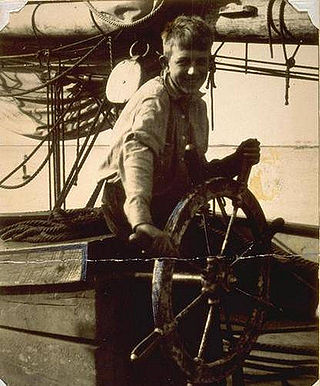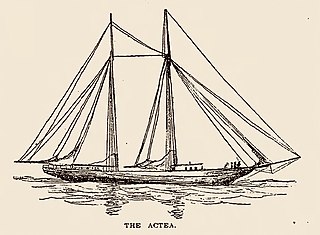
L. A. Dunton is a National Historic Landmark fishing schooner and museum exhibit located at the Mystic Seaport Museum in Mystic, Connecticut. Built in 1921, she is one of three remaining vessels afloat of this type, which was once the most common sail-powered fishing vessel sailing from New England ports. In service in New England waters until the 1930s and Newfoundland into the 1950s. After a brief period as a cargo ship, she was acquired by the museum and restored to her original condition.

John Faunce Leavitt (1905–1974) was a well-known shipbuilder, writer on maritime subjects, painter of marine canvases, and curator of Mystic Seaport in Mystic, Connecticut.

Samuel Havre Pine, was a 19th-century American ship designer and builder located in Greenpoint, Brooklyn. He built the racing yacht Enchantress as well as many sailing schooners and yachts; steam yachts; and steamships.

Alexander M. Lawrence was the last of the 19th-century sailing schooners to be in the New York pilot boat service as a station boat. She was one of the largest and fastest in the Sandy Hook fleet. She was built to take the place of the New York pilot-boat Abraham Leggett, No. 4, that was hit by the steamship Naples, in 1879. Her boat model won a medal at the 1893 Chicago World's Fair illustrating the perils of the pilot-boat service. In the age of steam, the Lawrence was sold by the Pilots' Association to the Pacific Mining and Trading Company in 1897.

C. & R. Poillon was a 19th-century shipyard company in Brooklyn, New York. The company employed over 300 workers, owned several shipyards, and launched 175 vessels. The company was one of the best known clipper ship firms and the last of the wooden hulled boat builders in New York.

The Moses H. Grinnell was a 19th-century pilot boat built in 1850 for the New York maritime pilots. She was designed by the yacht designer George Steers. The Grinnell was the first pilot boat to feature a fully developed concave clipper-bow, which was to become the New York schooner-rigged pilot boat's trade mark. This new design was the basis for the celebrated yacht America.

The Edward C. Knight, also known as the E. C. Knight, was a 19th-century pilot boat built by the C. & R. Poillon shipyard in 1875 for the Delaware River Pilots. She was the finest and fastest pilot-boat belonging to the Philadelphia port. She was sold to the Brunswick Pilots' Association of Georgia in 1898.

The Sylph was a 19th-century pilot boat first built in 1834, by Whitmore & Holbrook for John Perkins Cushing as a Boston yacht and pilot-boat for merchant and ship owner Robert Bennet Forbes. She won the first recorded American yacht race in 1835. She was a pilot boat in the Boston Harbor in 1836 and 1837 and sold to the New York and Sandy Hook Pilots in October 1837. She was lost in winter of 1857 with all hands during a blizzard off Barnegat, New Jersey. The second Sylph was built in 1865 from a half-model by Dennison J. Lawlor. The third Sylph was built in 1878 at North Weymouth, Massachusetts for Boston Pilots. She was sold out of service in 1901, after 23 years of Boston pilot service.

James H. Reid, was a 19th-century American Maritime pilot. He is best known for being the dean of the Boston pilots, serving for 55 years. He was captain of the famous yacht America for 17 years when she was owned by Benjamin F. Butler. In 1897, he built a new America, named after the America's Cup defender.

Abel F. Hayden, was a 19th-century American Maritime pilot. He was one of the oldest Boston pilots, serving for over thirty years. He helped bring in the USS San Jacinto, into the Boston Harbor in 1861. Hayden was owner of the pilot-boat D. J. Lawlor, that was struck by a fishing schooner Horace B. Parker, in 1895.

The Thomas S. Negus was a 19th-century two-masted Sandy Hook pilot boat, built by C. & R. Poillon shipyard in Brooklyn in 1873 for the New Jersey maritime pilots. She was built to replace the pilot boat Jane, No. 1, which sank in early 1873. She was the winner of a $1,000 prize at the Cape May Regatta in 1873. She was named for Thomas S. Negus, president of the N. J. Pilots' Commissioners. In 1897, she left the pilot service to prospect for gold during the Klondike Gold Rush.

The Edward E. Barrett, or Edward E. Bartlett, was a 19th-century two-masted Sandy Hook pilot boat, built by C. & R. Poillon in 1883 and designed by William Townsend. She helped transport New Jersey maritime pilots between inbound or outbound ships coming into the New York Harbor. She was one of the pilot boats that survived the Great Blizzard of 1888. In the age of steam, the Barrett ended her pilot commission and was sold in 1904.

The Actaea, or Actea, was a 19th-century Boston yacht built in 1880 by Weld and David Clark of Kennebunk, Maine for David Sears, Jr., of Montgomery Sears of Boston. She was purchased by a group of New York Sandy Hook Pilots in 1890. She was one of the largest and fastest pilot boats in the fleet. In the age of steam, the Actaea was sold in 1896 to John J. Phelps of the New York Yacht Club and used as a pleasure yacht.

The James W. Elwell was a 19th-century two-masted Sandy Hook pilot boat, built in 1867 by John A. Forsyth at Mystic Bridge, New London, Connecticut for New Jersey and Sandy Hook maritime pilots. She raced for a $1,000 prize at the Cape May Regatta in 1873. She went ashore and was shipwrecked on North Beach Haven, New Jersey in 1875.
The Pilots' Association For The Bay & River Delaware is the official maritime pilot group for the Delaware Bay and Delaware River. The association is one of the oldest state pilot organizations in the nation that was founded in 1896. Delaware Bay Pilots are licensed maritime pilots for the Delaware Bay and River. Delaware pilots guide oceangoing vessels, passenger liners, freighters and tankers in and out of the harbor. The Delaware Bay is bordered inland by the States of New Jersey and Delaware, and the Delaware Capes, Cape Henlopen to the south and Cape May to the north, on the Atlantic Ocean.

The Thomas Howard was a 19th-century pilot boat built by the William Cramp & Sons in 1870 for the Philadelphia Pilots' Association. She was the finest and fastest pilot-boat belonging to the Philadelphia port. In 1886, the Pilots' Association for the State of Delaware declared that the Thomas Howard become a Delaware pilot boat.

The Enoch Turley was a 19th-century Pennsylvania pilot schooner built in 1842 in Baltimore, Maryland. In the 1880s she was caught up in the competition and rivalry between New Jersey and Pennsylvania pilots and the Delaware pilots. She survived the Great Blizzard of 1888, but was swept away in 1889, with all hands lost, during a powerful gale.

The Ebe W. Tunnell was a 19th-century Delaware pilot schooner built in 1887 in Brooklyn, New York. In 1889, the Tunnell was driven out to sea in a fierce storm. The crew spent five days in turbulent waters before they were rescued. In the age of steam, Ebe W. Tunnell had outlived its usefulness and was sold as a houseboat for a group of men working in the Chesapeake Bay in 1909.

The J. Henry Edmunds was a 19th-century pilot schooner built in 1887 in Brooklyn, New York for Philadelphia pilots. She sank in 1892 and a second Edmunds was built in 1893, which lasted thirty-five years before she sank in bad weather outside Cape Henlopen in 1928. She was the last schooner-rigged pilot boat in the Delaware Bay.

















